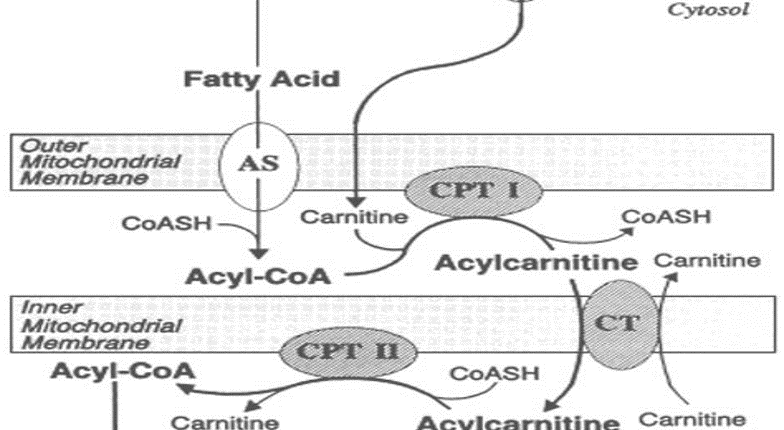Library
“Differentiating Carnitine Deficiency and Enzyme Deficiencies in the Carnitine Shuttle: Clinical and Laboratory Insights”
- November 7, 2024
- Posted by: Namrata Chhabra
- Category: Energy metabolism Learning resources Library Metabolism of lipids Quick Revision Series Quick revisions Quick revisions USMLE Content

Clinical Case:
A 6-year-old boy presents to the emergency department with episodes of severe muscle weakness, fatigue, and dark-colored urine after prolonged physical activity. His parents report that he often becomes weak during periods of fasting or intense exercise. Blood tests reveal elevated levels of fatty acylcarnitine and normal levels of free carnitine. Plasma analysis shows increased long-chain fatty acids and low levels of ketone bodies.
Based on the clinical presentation and lab results, which of the following enzyme deficiencies is most likely responsible for the boy’s condition?
A. Acyl-CoA synthetase
B. Carnitine Acyltransferase-I (CAT-I)
C. Carnitine/Acylcarnitine Translocase (CACT)
D. Carnitine Acyltransferase-II (CAT-II)
E. Primary Carnitine Deficiency
Correct Answer:
D. Carnitine Acyltransferase-II (CAT-II). The lab findings of elevated fatty acyl carnitine with normal free carnitine levels point to a deficiency in CAT-II. This enzyme is responsible for converting fatty acyl carnitine back to fatty acyl CoA in the mitochondria (see figure below). A deficiency in CAT-II leads to an accumulation of fatty acyl carnitine, impaired fatty acid oxidation, and low ketone body production, especially during fasting or physical stress.

Figure- Transportation of fatty acyl CoA through carnitine shuttle.
Explanation:
Incorrect Options:
- A. Acyl-CoA synthetase: A deficiency here would impair the initial activation of fatty acids and would result in low levels of fatty acyl CoA and fatty acyl carnitine, not elevated fatty acylcarnitine.
- B. Carnitine Acyltransferase-I (CAT-I): A deficiency in CAT-I would result in low levels of fatty acylcarnitine and elevated levels of long-chain fatty acids, but it would not explain the elevated fatty acylcarnitine.
- C. Carnitine/Acylcarnitine Translocase (CACT): CACT deficiency would also lead to elevated fatty acyl carnitine, but it is often accompanied by slight decreases in free carnitine levels.
- E. Primary Carnitine Deficiency: This condition would result in low carnitine levels and reduced fatty acyl carnitine, not elevated levels.
Here’s a table summarizing the blood estimations and differentiating features between carnitine deficiency and enzyme deficiencies of the carnitine shuttle:
| Parameter | Primary Carnitine Deficiency | CAT-I Deficiency | CACT Deficiency | CAT-II Deficiency |
| Carnitine Levels | Low | Normal | Normal to slightly low | Normal |
| Fatty Acyl Carnitine Levels | Low to normal | Low | Elevated | Elevated |
| Long-Chain Fatty Acids | Elevated | Elevated | Elevated | Elevated |
| Ketone Bodies | Low (especially during fasting) | Low | Low | Low |
| Glucose Levels | Low (hypoglycemia) | Low (hypoglycemia) | Low (hypoglycemia) | Low (hypoglycemia) |
| Key Differentiating Feature | Low carnitine in blood | Low fatty acylcarnitine | Elevated fatty acylcarnitine | Elevated fatty acylcarnitine |
Explanation of the reasons behind the findings in each condition:
- Primary Carnitine Deficiency
- Low Carnitine Levels: The body lacks sufficient carnitine for transporting long-chain fatty acids into the mitochondria due to defects in carnitine uptake or synthesis.
- Low to Normal Fatty Acyl Carnitine Levels: Without adequate carnitine, fatty acyl CoA cannot be converted effectively to fatty acyl carnitine, limiting the formation of this compound.
- Elevated Long-Chain Fatty Acids: Fatty acids accumulate in the blood because they cannot be transported into the mitochondria for beta-oxidation.
- Low Ketone Bodies: Impaired beta-oxidation means reduced ketogenesis, leading to low levels of ketone bodies.
- Low Glucose Levels: The body relies on glucose for energy due to impaired fatty acid oxidation, leading to hypoglycemia.
- Carnitine Acyltransferase-I (CAT-I) Deficiency
- Normal Carnitine Levels: The carnitine supply is unaffected; the issue lies in the enzyme that converts fatty acyl CoA to fatty acylcarnitine.
- Low Fatty Acyl Carnitine Levels: CAT-I deficiency prevents the formation of fatty acyl carnitine, limiting the transport of fatty acids into the mitochondria.
- Elevated Long-Chain Fatty Acids: Fatty acids accumulate due to their inability to enter the mitochondria.
- Low Ketone Bodies: Beta-oxidation is reduced, resulting in lower ketone body production.
- Low Glucose Levels: Increased reliance on glucose for energy leads to hypoglycemia.
- Carnitine/Acylcarnitine Translocase (CACT) Deficiency
- Normal to Slightly Low Carnitine Levels: Carnitine recycling is disrupted but not completely impaired.
- Elevated Fatty Acyl Carnitine Levels: The transport of fatty acyl carnitine into the mitochondrial matrix is blocked, causing accumulation in the blood.
- Elevated Long-Chain Fatty Acids: Fatty acids accumulate because they cannot be fully processed for energy production.
- Low Ketone Bodies: Impaired transport leads to reduced beta-oxidation and, consequently, low ketogenesis.
- Low Glucose Levels: The body shifts to using glucose for energy due to the defect in fatty acid oxidation, leading to hypoglycemia.
- Carnitine Acyltransferase-II (CAT-II) Deficiency
- Normal Carnitine Levels: Carnitine levels remain unaffected, as CAT-II acts after the transport of fatty acyl carnitine into the mitochondria.
- Elevated Fatty Acyl Carnitine Levels: A defect in CAT-II leads to the accumulation of fatty acyl carnitine within the mitochondria, which may spill into the bloodstream.
- Elevated Long-Chain Fatty Acids: Fatty acid processing is limited due to the impaired conversion of fatty acylcarnitine to fatty acyl CoA.
- Low Ketone Bodies: Reduced beta-oxidation means ketone body production is diminished.
- Low Glucose Levels: The body relies more on glucose when fatty acid oxidation is compromised, causing hypoglycemia during fasting or exertion.
Summary:
- Primary Carnitine Deficiency is identified by low carnitine levels and potentially low fatty acyl carnitine, with elevated long-chain fatty acids and low ketone bodies.
- CAT-I Deficiency shows normal carnitine levels with low fatty acylcarnitine and similar metabolic disturbances (elevated long-chain fatty acids and low ketones).
- CACT Deficiency is characterized by elevated fatty acylcarnitine and normal to slightly low carnitine levels.
- CAT-II Deficiency presents with elevated fatty acylcarnitine and normal carnitine levels, leading to muscle weakness and hypoglycemia, especially after fasting.
